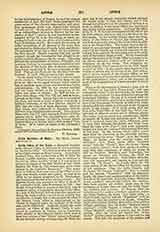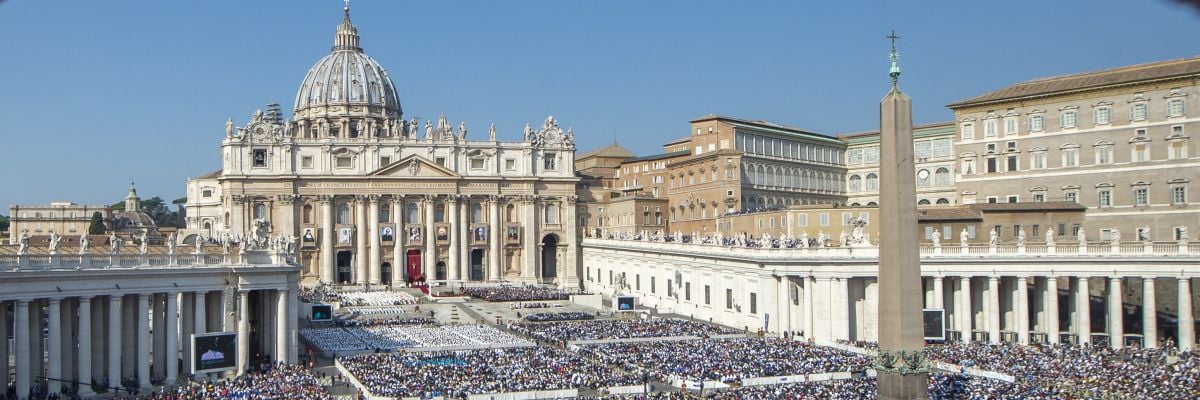

Litany (Lat. litania, letania, from Gr. lite, prayer or supplication), a well-known and much appreciated form of responsive petition, used in public liturgical services, and in private devotions, for common necessities of the Church, or in calamities—to implore God‘s aid or to appease His just wrath. This form of prayer finds its model in Psalm cxxxv: “Praise the Lord, for he is good: for his mercy endureth for ever. Praise ye the God of gods… the Lord of lords… Who alone doth great wonders… Who made the heavens”, etc., with the concluding words in each verse, “for his mercy endureth for ever.” Similar is the canticle of praise by the youths in the fiery furnace (Dan., iii, 57-87), with the response, “praise and exalt him above all for ever.” In the Mass of the Oriental Church we find several litanies in use even at the present day. Towards the end of the Mass of the catechumens the deacon asks all to pray; he formulates the petitions, and all answer “Kyrie Eleison“. When the catechumens have departed, the deacon asks the prayers: for the peace and welfare of the world, for the Holy, Catholic, and Apostolic Church, for the bishops and priests, for the sick, for those who have gone astray, etc., to each of which petitions the faithful answer “Kyrie Eleison“, or “Grant us, O Lord”, or “We beseech Thee.” The litany is concluded by the words, “Save us, restore us again, O Lord, by Thy mercy.” The last petitions in our Litany of the Saints, with the responses “Deliver us, O Lord” and “We beseech Thee hear us”, show a great resemblance to the Mass Litany of the Greek Church. In the Ambrosian or Milanese Rite two litanies are recited on the Sundays of Lent instead of the “Gloria in excelsis”. In the Stowe Missal a litany is inserted between the Epistle and Gospel (Duchesne, “Christian Worship“, London, 1904, 199). The Roman Missal has retained the prayers for all classes of people in the Mass of the Pre-sanctified on Good Friday, a full litany on Holy Saturday, and the triple repetition of “Kyrie Eleison“, “Christe Eleison”, “Kyrie Eleison“, in every Mass. The frequent repetition of the “Kyrie” was probably the original form of the Litany, and was in use in Asia and in Rome at a very early date. The Council of Vaison in 529 passed the decree: “Let that beautiful custom of all the provinces of the East and of Italy be kept up, viz., that of singing with great effect and compunction the `Kyrie Eleison‘ at Mass, Matins, and Vespers, because so sweet and pleasing a chant, even though continued day and night without interruption, could never produce disgust or weariness “The number of repetitions depended upon the celebrant. This litany is prescribed in the Roman Breviary at the “Preces Feriales” and in the Monastic Breviary for every “Nora” (Rule of St. Benedict, ix, 17). The continuous repetition of the “Kyrie” is used today at the consecration of a church, while the relics to be placed in the altar are carried in procession around the church. Because the “Kyrie” and other petitions were said once or oftener, litanies were called plants, ternce, quints, septence.
When peace was granted to the Church after three centuries of bloody persecution, public devotions became common and processions were frequently held, with preference for days which the heathens had held sacred. These processions were called litanies, and in them pictures and other religious emblems were carried. In Rome, pope and people would go in procession each day, especially in Lent, to a different church, to celebrate the Sacred Mysteries. Thus originated the Roman “Stations”, and what was called the “Litania Major”, or “Romana”. It was held on April 25, on which day the heathens had celebrated the festival of Robigalia, the principal feature of which was a procession. The Christian litany which replaced it set out from the church of S. Lorenzo in Lucina, held a station at S. Valentino Outside the Walls, and then at the Milvian Bridge. From thence, instead of proceeding on the Claudian Way, as the heathens had done, it turned to the left towards the Vatican, stopped at a cross, of which the site is not given, and again in the paradise or atrium of St. Peter’s, and finally in the basilica itself, where the station was held (Duchesne, 288). In 590, when a pestilence caused by an overflow of the Tiber was ravaging Rome, Gregory the Great commanded a litany which is called “Septiformis”; on the preceding day he exhorted the people to fervent prayer, and arranged the order to be observed in the procession, viz. that the clergy from S. Giovanni Battista, the men from S. Marcello, the monks from SS. Giovanni e Paolo, the unmarried women from SS. Cosma e Damiano, the married women from San Stefano, the widows from S. Vitale, the poor and the children from S. Cmeilia, were all to meet at S. Maria Maggiore. The “Litania Minor“, or “Gallicana”, on the Rogation Days before Ascension, was introduced (477) by St. Mamertus, Bishop of Vienne, on account of the earthquakes and other calamities then prevalent. It was prescribed for the whole of Frankish Gaul, in 511, by the Council of Orleans (can. xxvii). For Rome it was ordered by Leo III, in 799. In the Ambrosian Rite this litany was celebrated on Monday, Tuesday, and Wednesday after Ascension. In Spain we find a similar litany from Thursday to Saturday after Whitsuntide, another from the first to third of November, ordered by the Council of Gerunda in 517, and still another for December, commanded by the synod of Toledo in 638. In England the Litany of Rogation Days (Gang-Days) was known in the earliest periods. In Germany it was ordered by a Synod of Mainz in 813. Owing to the fact that the Mass Litany became popular through its use in processions, numberless varieties were soon made, especially in the Middle Ages. Litanies appeared in honor of God the Father, of God the Son, of God the Holy Ghost, of the Precious Blood, of the Blessed Virgin, of the Immaculate Conception, of each of the saints honored in different countries, for the souls in Purgatory, etc. In 1601 Baronius wrote that about eighty forms were in circulation. To prevent abuse, Pope Clement VIII, by decree of the Inquisition of September 6, 1601, forbade the publication of any litany, except that of the saints as found in the liturgical books and that of Loreto. Today the litanies approved for public recitation are: of All Saints, of Loreto, of the Holy Name, of the Sacred Heart, and of St. Joseph.
FRANCIS MERSHMAN


